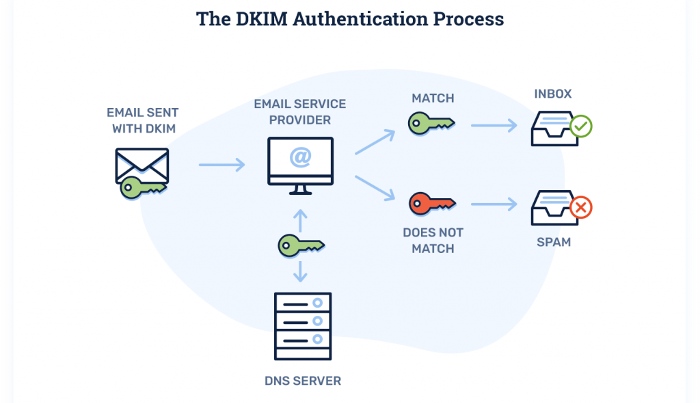
DKIM stands for DomainKeys Identified Mail, an email authentication protocol that prevents hackers from tampering with email content in transit. It has emerged as a powerful protocol that’s based on the concept of generating and updating public and private keys that are matched at the recipient’s end to ensure that nobody intercepted the message and it has come from a verified sender and domain name.
A DKIM checker is one of the email investigation tools that identify and highlight issues to keep spammers and phishing attacks at a distance.
How DKIM Works and Safeguards Companies From Spoofing and Phishing?
DKIM performs email authentication by adding a digital signature to the email’s header, which is then verified by the recipient’s mail server by extracting the DKIM record corresponding to the sending domain where the public digital signature is stored. DKIM verification passes if both the signatures match.
The DKIM signature is generated using encryption techniques and involves a pair of cryptographic keys; the sender’s mail server holds the private key, while the public key is stored in the sender domain’s DNS.

Image sourced from rejoiner.com
The entire process shields a company from reputational and financial damages by assuring the following-
Sender Authentication and Reduced Spoofing
DKIM helps evaluate the sender’s authenticity by matching the keys and segregating potentially fraudulent messages from genuine ones. So, even if a malicious actor tries to spoof your domain name to dispatch emails, there’s a very low possibility of recipients engaging with such messages as their mailboxes will mark them as suspicious.
However, in the absence of a DKIM record, hackers can manipulate email receivers into sharing sensitive information, wire transferring money, or downloading malware-infected files by impersonating themselves as someone from your company.
Content Integrity
The key-based authentication protocol ensures that the message’s content isn’t altered in transit. Any modifications invalidate the signature, making it evident for receiving mail servers to identify them as potentially fraudulent and malicious.
Enhanced Trust
Companies that implement DKIM authentication send a clear message to their recipients that they take email security seriously. This builds trust with customers and partners who can rely on the authenticity of their communications.
Improved Domain Authority and Email Deliverability
The overall practice of email security instills trust in mail servers that your domain is not involved in wrongful and threatening practices, which consequently boosts your domain authority and email deliverability. A good email delivery rate ensures that most of your emails fall into the primary inboxes rather than spam folders.

Performing a DKIM Record Check
DKIM record check refers to the process of evaluating your record manually or using a tool to come across syntax errors. It also proves that there’s a public record associated with a given DKIM selector. A DKIM selector is a string that helps locate the specific private key used to sign the email and is attached to the email header along with the digitally encrypted signature.
A DKIM record checker or lookup tool flags warnings for issues it spots in the submitted TXT record.
Ways to Perform a DKIM Record Check
Domain owners should prioritize email security using SPF, DKIM, and DMARC to steer clear of phishing and spoofing attacks that can even make them liable to legal issues and penalties imposed due to their lack of securing customer data. In 2020, the Information Commissioner’s Office (ICO) announced a GDPR fine of £18.4 million on hotel giant Marriott International for failing to secure confidential details of the guests.
Coming across such hefty penalty news, you can’t take the risk of not performing a regular DKIM record check through one of the following methods-
Manual Verification
Carefully read the email header for a DKIM signature field to manually retrieve the public keys from the DNS records and compare it with your signature. You can do a manual DKIM DNS record check with the Dig by following these steps-
- Open the console or command line on your computer.
- Type dig <selector>._domainkey.<domain> TXT where <selector> is the DKIM selector and <domain> is the domain name.
- Execute the command by hitting the Enter button.
- The output will display the DKIM DNS record for the domain, including the public key and other information.
Email Security Software
You can go to Google, search for ‘DKIM record check,’ and come across multiple platforms offering this service for free. All you have to do is open the investigation tool and add the domain name and selector in the given space. You will gain visibility into specific DKIM signature issues that you can fix timely.
Email Service Provider Authentication
Google Workspace and Microsoft 365 use default DKIM keys as part of their email services. Non-custom Gmail domains use GAPPSSMTP keys. However, it’s suggested to create and update a customer-specific DKIM DNS record for your domain, which is a fairly simple task, and the ESP handles the rest.
Email Security Gateways
Email security gateways or secure email gateways filter incoming and outgoing messages to identify emails that are likely to be fraudulent in nature. Generally, these gateways are capable of integrating directly with cloud email platforms like Microsoft 365 and Google Workspace.
Libraesva ESG and SpamTitan are two such service providers that offer multi-layered threat protection by analyzing SPF, DKIM, and DMARC, along with other security factors like URL and attachment analysis.
How to Check DKIM Records in Your DNS?
Simply go to your DNS provider and login. Then go to the ‘records page’ and search for a TXT or CNAME type record with the Host/ Name similar to this example string:
[selector]._domainkey. yourdomain.comYou’ll get the same results as a record-checking tool.

How Many DKIM Records Can You Have?
Technically, there’s no cap on the number of DKIM records you can have, however, there’s a limitation on the number of records your DNS provider can handle. So, for multiple DKIM records, you’ll have to use multiple selectors for individual email-sending services.
Conclusion
In the battle against email spoofing and phishing, DKIM record check is a valuable weapon for businesses. It not only helps protect a company’s reputation and data but also fosters trust among customers and partners. With the ever-increasing sophistication of cyber threats, implementing robust email authentication mechanisms like DKIM is essential. By making use of the methods outlined above, organizations can take a significant step toward strengthening their email security and ensuring the integrity of their communication channels.